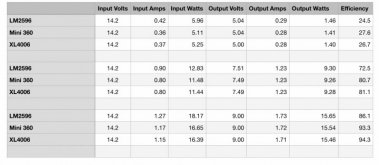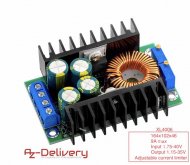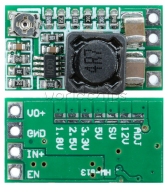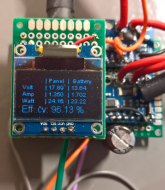Sverige
A Brit in Sweden
I ordered a few different types of DC/DC converter modules from amazon all of which had vague specs like “up to 95% efficient“, so I started to wonder how efficient they really were in the application I wanted to use them in.
All work in a similar way - you connect a DC voltage at the input then adjust a potentiometer on the board to set the output voltage to your desired level. Step up and step down modules are available - all of these were step down modules where the output voltage must always be at least half a volt lower than the input. Output voltage then remains fixed even when the input voltage varies, which is a really great feature.
These are great for taking DC straight from your house bank battery DC load centre to all those devices which normally use a ”wall wart” AC adapter (which can then be retired from use, reducing your overall energy consumption).
These modules are so cheap! The mini 360s were €7.99 for a ten pack, the LM2596S about €1.36 each and the more powerful XL4016 units €6 each. I’m attaching some photos of the units with summary specs and below are the test results I obtained when comparing their performance converting down from 14V to 9V, 7.5V and 5V.
Clearly the overall conversion efficiency is highest when the volt drop from input to output is minimised and also as output current grows, so does the efficiency. This makes sense if you consider that each module has a self-consumption current which gets taken from “the bottom line”.
I didn’t expect to see an efficiency as high as 94% in a real world test, but the XL4006 achieved this with output of 9V and 1.7A. This was not an exhaustive test and I didn’t adjust test parameters in search of the highest efficiency numbers, I simply tested them with the output voltages and currents I expect to use in my home.
Despite the XL4006 being the winner, I think the most impressive device was the mini 360, which is the size of a postage stamp, very cheap and performed almost as well as the larger module. The only drawback is the tiny pot on the mini 360 is quite hard to set accurately. These units must have a ton of applications in distributing DC around an off grid home - hope the test gives some useful info, even though it’s a partial one.




All work in a similar way - you connect a DC voltage at the input then adjust a potentiometer on the board to set the output voltage to your desired level. Step up and step down modules are available - all of these were step down modules where the output voltage must always be at least half a volt lower than the input. Output voltage then remains fixed even when the input voltage varies, which is a really great feature.
These are great for taking DC straight from your house bank battery DC load centre to all those devices which normally use a ”wall wart” AC adapter (which can then be retired from use, reducing your overall energy consumption).
These modules are so cheap! The mini 360s were €7.99 for a ten pack, the LM2596S about €1.36 each and the more powerful XL4016 units €6 each. I’m attaching some photos of the units with summary specs and below are the test results I obtained when comparing their performance converting down from 14V to 9V, 7.5V and 5V.
Clearly the overall conversion efficiency is highest when the volt drop from input to output is minimised and also as output current grows, so does the efficiency. This makes sense if you consider that each module has a self-consumption current which gets taken from “the bottom line”.
I didn’t expect to see an efficiency as high as 94% in a real world test, but the XL4006 achieved this with output of 9V and 1.7A. This was not an exhaustive test and I didn’t adjust test parameters in search of the highest efficiency numbers, I simply tested them with the output voltages and currents I expect to use in my home.
Despite the XL4006 being the winner, I think the most impressive device was the mini 360, which is the size of a postage stamp, very cheap and performed almost as well as the larger module. The only drawback is the tiny pot on the mini 360 is quite hard to set accurately. These units must have a ton of applications in distributing DC around an off grid home - hope the test gives some useful info, even though it’s a partial one.










